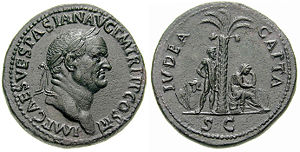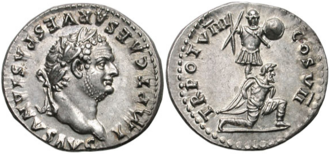
Judaea Capta coinage
Encyclopedia



Roman Emperor
The Roman emperor was the ruler of the Roman State during the imperial period . The Romans had no single term for the office although at any given time, a given title was associated with the emperor...
Vespasian
Vespasian
Vespasian , was Roman Emperor from 69 AD to 79 AD. Vespasian was the founder of the Flavian dynasty, which ruled the Empire for a quarter century. Vespasian was descended from a family of equestrians, who rose into the senatorial rank under the Emperors of the Julio-Claudian dynasty...
to celebrate the capture of Judaea
Iudaea Province
Judaea or Iudaea are terms used by historians to refer to the Roman province that extended over parts of the former regions of the Hasmonean and Herodian kingdoms of Israel...
and the destruction of the Jewish Temple in Jerusalem
Temple in Jerusalem
The Temple in Jerusalem or Holy Temple , refers to one of a series of structures which were historically located on the Temple Mount in the Old City of Jerusalem, the current site of the Dome of the Rock. Historically, these successive temples stood at this location and functioned as the centre of...
by his son Titus
Titus
Titus , was Roman Emperor from 79 to 81. A member of the Flavian dynasty, Titus succeeded his father Vespasian upon his death, thus becoming the first Roman Emperor to come to the throne after his own father....
in 70 AD during the First Jewish Revolt
First Jewish-Roman War
The First Jewish–Roman War , sometimes called The Great Revolt , was the first of three major rebellions by the Jews of Judaea Province , against the Roman Empire...
. There are several variants of the coinage. The reverse of the coins shows a female (representing Jerusalem?) seated right in an attitude of mourning at the base of a palm tree, with either a captive bearded male (representing Judah
Judea
Judea or Judæa was the name of the mountainous southern part of the historic Land of Israel from the 8th century BCE to the 2nd century CE, when Roman Judea was renamed Syria Palaestina following the Jewish Bar Kokhba revolt.-Etymology:The...
?) standing left, with his hands bound behind his back, or the standing figure of the victorious emperor, or the goddess Victory, with a trophy
Tropaion
A tropaion , whence English "trophy" is an ancient Greek and later Roman monument set up to commemorate a victory over one's foes. Typically this takes the shape of a tree, sometimes with a pair of arm-like branches upon which is hung the armour of a defeated and dead foe...
of weapons, shields, and helmets to the left.
The female figure may reflect the prophecy of Isaiah
Isaiah
Isaiah ; Greek: ', Ēsaïās ; "Yahu is salvation") was a prophet in the 8th-century BC Kingdom of Judah.Jews and Christians consider the Book of Isaiah a part of their Biblical canon; he is the first listed of the neviim akharonim, the later prophets. Many of the New Testament teachings of Jesus...
3:8, 25-26: "For Jerusalem is ruined, and Judah is fallen ... Thy men shall fall by the sword and thy mighty in the war. And her gates shall lament and mourn, and she being desolate shall sit upon the ground".
The Judaea Capta coins were struck for 25 years under Vespasian and his two sons who succeeded him as Emperor - Titus and Domitian
Domitian
Domitian was Roman Emperor from 81 to 96. Domitian was the third and last emperor of the Flavian dynasty.Domitian's youth and early career were largely spent in the shadow of his brother Titus, who gained military renown during the First Jewish-Roman War...
. These commemorative coins were issued in bronze, silver and gold by mints in Rome, throughout the Roman Empire
Roman Empire
The Roman Empire was the post-Republican period of the ancient Roman civilization, characterised by an autocratic form of government and large territorial holdings in Europe and around the Mediterranean....
, and in Judaea itself. They were issued in every denomination, and at least 48 different types are known.
Only bronze 'Judaea Capta' coins were struck in Caesarea, in the defeated Roman province of Judea. These coins are much cruder than the Roman issues, and the inscriptions are in Greek
Greek language
Greek is an independent branch of the Indo-European family of languages. Native to the southern Balkans, it has the longest documented history of any Indo-European language, spanning 34 centuries of written records. Its writing system has been the Greek alphabet for the majority of its history;...
rather than Latin
Latin
Latin is an Italic language originally spoken in Latium and Ancient Rome. It, along with most European languages, is a descendant of the ancient Proto-Indo-European language. Although it is considered a dead language, a number of scholars and members of the Christian clergy speak it fluently, and...
. The designs feature the Goddess Nike
Nike (mythology)
In Greek mythology, Nike was a goddess who personified victory, also known as the Winged Goddess of Victory. The Roman equivalent was Victoria. Depending upon the time of various myths, she was described as the daughter of Pallas and Styx and the sister of Kratos , Bia , and Zelus...
writing on a shield, Minerva
Minerva
Minerva was the Roman goddess whom Romans from the 2nd century BC onwards equated with the Greek goddess Athena. She was the virgin goddess of poetry, medicine, wisdom, commerce, weaving, crafts, magic...
with a spear, shield, trophy and palm tree, etc. Most such coins were issued during the reign of the Emperor Domitian (81-96 AD).
Unusually, a 'Judaea Capta' coin was also minted by the Jewish ruler Agrippa II
Agrippa II
Agrippa II , son of Agrippa I, and like him originally named Marcus Julius Agrippa, was the seventh and last king of the family of Herod the Great, thus last of the Herodians. He was the brother of Berenice, Mariamne, and Drusilla...
, the great-grandson of Herod the Great
Herod the Great
Herod , also known as Herod the Great , was a Roman client king of Judea. His epithet of "the Great" is widely disputed as he is described as "a madman who murdered his own family and a great many rabbis." He is also known for his colossal building projects in Jerusalem and elsewhere, including his...
. Brought up in Rome at the court of Claudius
Claudius
Claudius , was Roman Emperor from 41 to 54. A member of the Julio-Claudian dynasty, he was the son of Drusus and Antonia Minor. He was born at Lugdunum in Gaul and was the first Roman Emperor to be born outside Italy...
, Agrippa was thoroughly Romanised and was a close friend of Titus
Titus
Titus , was Roman Emperor from 79 to 81. A member of the Flavian dynasty, Titus succeeded his father Vespasian upon his death, thus becoming the first Roman Emperor to come to the throne after his own father....
, whom he supported throughout the First Jewish Revolt
First Jewish-Roman War
The First Jewish–Roman War , sometimes called The Great Revolt , was the first of three major rebellions by the Jews of Judaea Province , against the Roman Empire...
. His bronze coin was minted at Tiberias and shows a portrait of Titus on the obverse
Obverse and reverse
Obverse and its opposite, reverse, refer to the two flat faces of coins and some other two-sided objects, including paper money, flags , seals, medals, drawings, old master prints and other works of art, and printed fabrics. In this usage, obverse means the front face of the object and reverse...
with the Greek
Greek language
Greek is an independent branch of the Indo-European family of languages. Native to the southern Balkans, it has the longest documented history of any Indo-European language, spanning 34 centuries of written records. Its writing system has been the Greek alphabet for the majority of its history;...
inscription 'ΚΑΙΣΑΡ ΣΕΒΑΣ ΑΥΤΟΚΡ ΤΙΤΟΣ', while the reverse
Obverse and reverse
Obverse and its opposite, reverse, refer to the two flat faces of coins and some other two-sided objects, including paper money, flags , seals, medals, drawings, old master prints and other works of art, and printed fabrics. In this usage, obverse means the front face of the object and reverse...
depicted the goddess Nike
Nike (mythology)
In Greek mythology, Nike was a goddess who personified victory, also known as the Winged Goddess of Victory. The Roman equivalent was Victoria. Depending upon the time of various myths, she was described as the daughter of Pallas and Styx and the sister of Kratos , Bia , and Zelus...
advancing right holding a wreath and palm branch over her shoulder, with a star in upper right field and the inscription 'ETO - KS BA AGRI-PPA'.
See also
- List of historical currencies
- First Jewish Revolt coinageFirst Jewish Revolt coinageFirst Jewish Revolt coinage was issued by the Jews after the Zealots captured Jerusalem and the Jewish temple from the Romans in 66 AD at the beginning of the First Jewish Revolt...
- Great Jewish RevoltFirst Jewish-Roman WarThe First Jewish–Roman War , sometimes called The Great Revolt , was the first of three major rebellions by the Jews of Judaea Province , against the Roman Empire...
- Jewish-Roman WarsJewish-Roman warsThe Jewish–Roman wars were a series of large-scale revolts by the Jews of Iudaea Province and Eastern Mediterranean against the Roman Empire. Some sources use the term to refer only to the First Jewish–Roman War and Bar Kokhba revolt...
- Siege of JerusalemSiege of Jerusalem (70)The Siege of Jerusalem in the year 70 AD was the decisive event of the First Jewish-Roman War. The Roman army, led by the future Emperor Titus, with Tiberius Julius Alexander as his second-in-command, besieged and conquered the city of Jerusalem, which had been occupied by its Jewish defenders in...
- Fall of MasadaMasadaMasada is the name for a site of ancient palaces and fortifications in the South District of Israel, on top of an isolated rock plateau, or horst, on the eastern edge of the Judean Desert, overlooking the Dead Sea. Masada is best known for the violence that occurred there in the first century CE...
- Arch of TitusArch of TitusThe Arch of Titus is a 1st-century honorific arch located on the Via Sacra, Rome, just to the south-east of the Roman Forum. It was constructed in c.82 AD by the Roman Emperor Domitian shortly after the death of his older brother Titus to commemorate Titus' victories, including the Siege of...
- Temple in JerusalemTemple in JerusalemThe Temple in Jerusalem or Holy Temple , refers to one of a series of structures which were historically located on the Temple Mount in the Old City of Jerusalem, the current site of the Dome of the Rock. Historically, these successive temples stood at this location and functioned as the centre of...
- Second TempleSecond TempleThe Jewish Second Temple was an important shrine which stood on the Temple Mount in Jerusalem between 516 BCE and 70 CE. It replaced the First Temple which was destroyed in 586 BCE, when the Jewish nation was exiled to Babylon...
External links
- Titus coinage, including Judaea Capta coins
- List of all the Judaea Capta coins with pictures and descriptions
- Vespasian coinage, including Judaea Capta coins
- Domitian coinage, including Judaea Capta coins
- Judaea Capta coins on The Handbook of Biblical Numismatics
- 'Judaea Capta' coins on Jewish History.com
- 'Judaea Capta' coins on Bible History.com
- Gold 'Judaea Capta' coin
- 'Judaea Capta' coinage on The Abraham Cowley Text and Image Archive
- 'Judaea Capta' coinage
- "Roman Coins Boast 'Judaea Capta'" Biblical Archaeology Society

